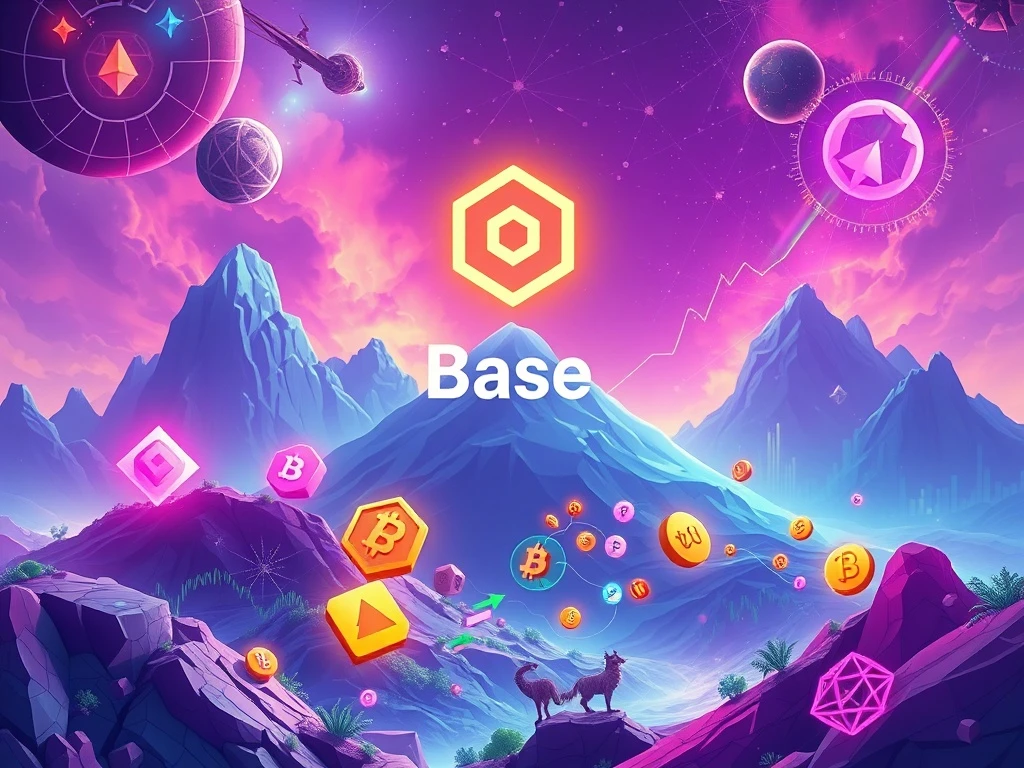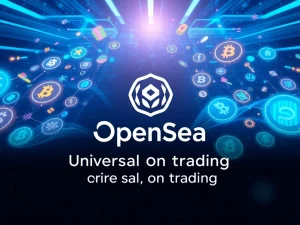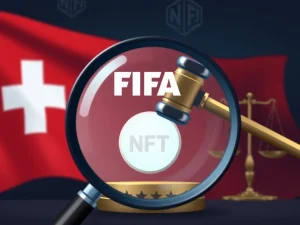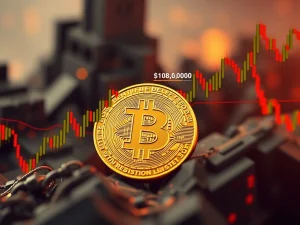Base NFT Volume Soars: Claims Top 3 Spot in Remarkable Surge

The digital asset landscape is constantly evolving, with new contenders emerging to challenge established giants. For enthusiasts keenly observing the cryptocurrency space, a significant shift has recently captivated attention: Base NFT volume has surged dramatically. This Coinbase-incubated Layer 2 network has not only solidified its presence but has also achieved a remarkable milestone, climbing into the top three for 30-day NFT trading volume. This ascent signals a dynamic period for non-fungible tokens and the underlying blockchain infrastructure supporting them.
Base NFT Volume Explodes: A New Challenger Rises
In a compelling display of growth, the Coinbase-developed Layer 2 network, Base, has captured the third position in non-fungible token (NFT) trading volume over the past 30 days. According to comprehensive metrics from decentralized application data aggregator, DappRadar, Base’s NFT volume reached an impressive $47.67 million. This figure represents a substantial 70% increase during the measurement period. This significant surge propels Base past several key competitors within the NFT ecosystem, including Immutable zkEVM and Solana, which now rank fourth and fifth respectively by 30-day volume. This rapid expansion underscores Base’s growing influence in the competitive NFT market.
Several distinct collections have played a pivotal role in fueling this extraordinary surge in digital collectible trading activity on the Base network. Specifically, collections such as Get Based, DX Terminal, and Based Style collectively recorded approximately $25 million in NFT trading volume. These popular projects have attracted a considerable number of traders and collectors, contributing significantly to Base’s overall market share. Furthermore, beyond just NFT volume, the DappRadar data reveals Base is fast becoming one of the busiest ecosystems in terms of overall network activity. Over the last 30 days, the network successfully processed more than 27 million transactions. It also handled over $16 billion in decentralized application (DApp) volume, which encompasses the total token transfers across various DApps within its robust network. This broad activity highlights Base’s growing utility and user adoption.
Understanding the Latest DappRadar NFT Data
The latest DappRadar NFT data offers a crucial snapshot of the current landscape of the non-fungible token market, providing valuable insights into market dominance and emerging trends. While Base demonstrates impressive upward momentum, Ethereum unequivocally maintains its position as the most dominant network for NFTs. DappRadar’s detailed statistics show that Ethereum recorded a staggering $408 million in NFT trading volume over the last 30 days. This substantial figure dwarfs the volumes seen on other chains, illustrating Ethereum’s enduring stronghold as the primary hub for high-value digital collectibles. Top-tier collections continue to drive this activity.
A closer look at Ethereum’s performance reveals that several iconic NFT collections are leading the charge. CryptoPunks, Pudgy Penguins, Moonbirds, the Bored Ape Yacht Club (BAYC), and Lil Pudgys collectively generated over $200 million in trading volume. These established projects consistently attract significant investor interest and trading activity. This dominance is not without its nuances, however. The broader market context includes both surges and corrections, which impact even the most prominent collections. Analyzing these trends helps us understand the resilience and volatility inherent in the NFT space. The continued high volume on Ethereum suggests that despite newer chains gaining traction, the foundational network remains critical for the NFT market’s health and direction.

Ethereum NFT Market: Enduring Dominance Amid Shifts
The Ethereum NFT market continues to showcase remarkable resilience and dominance, despite the rise of Layer 2 solutions and competing blockchains. Its foundational role in the NFT ecosystem is undeniable, hosting the majority of blue-chip collections and consistently attracting the highest trading volumes. While Base and Polygon have carved out significant niches, Ethereum’s ecosystem remains the benchmark for digital art and collectibles. The network’s robust infrastructure, extensive developer community, and established liquidity pools contribute to its sustained leadership. Furthermore, ongoing developments in scalability solutions, such as sharding and further Layer 2 integrations, aim to enhance Ethereum’s capacity and reduce transaction costs, potentially solidifying its long-term position.
However, the market is not static. Recent observations indicate a nuanced picture for some of Ethereum’s most prized digital assets. While high trading volumes persist, some blue-chip NFT collections have experienced recent downturns in their floor prices. This market behavior suggests a period of adjustment or consolidation, even within the most established segments of the NFT space. Despite these fluctuations, the overall sentiment around Ethereum-based NFTs remains strong, driven by their historical significance, cultural impact, and perceived long-term value. Investors and collectors often view these assets as digital heirlooms, contributing to their enduring appeal and the network’s continued relevance.
Polygon NFT Trading: Real-World Assets Driving Growth
Following Ethereum’s lead, Polygon has firmly established itself as the second-largest network by 30-day trading volume in the NFT space. The chain recorded an impressive $62.29 million in volume, reflecting a healthy 15% increase over the last month. This consistent growth highlights Polygon’s strategic importance as a scalable and cost-effective alternative for NFT creators and collectors. The network’s lower gas fees and faster transaction speeds make it an attractive platform for a diverse range of NFT projects, from gaming to digital art. This positions Polygon as a vital player in expanding the accessibility of NFTs to a broader audience.
A significant driver of Polygon NFT trading volume comes from innovative projects focusing on real-world assets (RWAs). Courtyard NFTs, which represent tokenized versions of physical items like trading cards, have taken up a substantial majority of Polygon’s NFT volumes. Specifically, Courtyard NFTs generated $57.65 million, marking a 21% increase in the last 30 days. This trend towards tokenizing tangible assets on the blockchain represents a crucial evolution in the NFT market. It bridges the gap between digital and physical ownership, offering new avenues for investment and collection. Polygon’s infrastructure proves particularly well-suited for these applications, facilitating the secure and efficient transfer of ownership for tokenized real-world assets.
The State of Blue-Chip NFTs Amidst Market Shifts
Despite the overall growth in NFT trading volumes across various networks, the market for blue-chip NFTs has experienced a period of adjustment. These high-value, established collections often serve as bellwethers for the broader NFT market. Recently, DefiLlama data revealed a notable drop in NFT floor prices for several top Ethereum-based collections. For instance, Pudgy Penguins, Bored Ape Yacht Club (BAYC), and Doodles all saw double-digit percentage declines in their floor prices. This downturn indicates a cooling-off period or a reallocation of capital within the high-end segment of the market. Investors are likely reassessing valuations amidst broader economic uncertainties and shifting sentiment.
However, not all blue-chip collections faced the same fate. CryptoPunks, another iconic and highly revered collection, demonstrated remarkable stability during this period. Its floor prices saw less than a 2% drop over the same timeframe. This resilience suggests that some blue-chip assets, particularly those with strong historical significance and cultural capital, may possess greater resistance to market fluctuations. The varying performance among these elite collections highlights the complex dynamics at play within the NFT ecosystem. While new networks like Base bring fresh energy and volume, the established blue-chips continue to navigate a market that balances innovation with traditional investment principles. Their performance offers critical insights into investor confidence and the evolving landscape of digital ownership.
The Future Outlook for NFT Ecosystems
The rapid ascent of Base into the top three for NFT trading volume signifies a pivotal moment for the entire digital collectibles market. It demonstrates the increasing viability and appeal of Layer 2 solutions for scaling blockchain activity. As more users and developers gravitate towards efficient and cost-effective networks, competition among chains will intensify. This competition ultimately benefits the end-user through improved infrastructure and diverse offerings. The continued innovation in areas like real-world asset tokenization, exemplified by Polygon’s success with Courtyard NFTs, also points to a broader integration of blockchain technology into everyday applications. These developments suggest a future where NFTs are not just digital art but also integral components of commerce, gaming, and various industries.
The sustained dominance of the Ethereum NFT market, alongside the strategic growth of Polygon and the explosive rise of Base, paints a picture of a multi-chain NFT future. Each network offers unique advantages, catering to different segments of the market. While Ethereum remains the home for premium, high-value collections, Layer 2s like Base and Polygon are crucial for expanding accessibility and fostering new use cases. The ongoing fluctuations in blue-chip NFT floor prices serve as a reminder of market cycles, yet the overall trend indicates robust growth and increasing mainstream acceptance of non-fungible tokens. As these ecosystems mature, they will likely continue to attract significant investment and innovation, shaping the next era of digital ownership and interaction.










